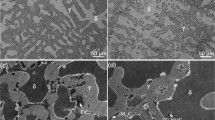Abstract
In order to study the effect of processing technology of Radium zinc anode for direct casting corrosion protection on the outer surface of BG110-3Cr casing on the properties of casing matrix and anode material. The mechanical properties and SEM fracture morphology of two sets of tensile specimens of casing material obtained by heating and casting heat conduction of resistance furnace were tested by metal material tensile test method, and then metallographic specimens were prepared for observation of microstructure. According to the properties of cast anode material, the content of melting elements in alloy was detected by ICP method and direct reading spectroscopy method respectively, and the content of melting elements in alloy was determined by electrochemical method. The polarization curves of the alloys were measured at 20 °C, 40 °C, 60 °C and 80 °C respectively, and the electrochemical properties were evaluated by comparing the polarization curves with those of the national standard anodes. The experimental results show that: (1) Rm and Rp0.2 of BG110-3Cr steel decrease to 913.1 MPa and 799.4 MPa respectively after heating up to 600 °C, the equiaxed dimples with uniform fracture surface become pits, the yield strength decreases, the carbide particles in tempered sorbite aggregate, the strength decreases, but the toughness increases, which is higher than API standard; (2) Under the influence of heat transfer and heating up of casting, the white distribution in the metallographic structure of the casing is 1–3 μm. Carbide particles, measured Rm and Rp0.2 increased to 1015.1 MPa and 890.5 MPa, respectively. (3) No macrosegregation and microscopic segregation were observed in the metallographic structure of the cast anode material. The polarization curve showed that the corrosion potential decreased with the increase of temperature. The corresponding corrosion potential at 80 °C was −1.09 V. No passivation was observed and the electrochemical performance was stable. The results provide technical support and theoretical basis for the processing of temperature-resistant anodes for cast anticorrosive casing and their application in the field of cathodic protection of deep well casing.
Copyright 2019, IPPTC Organizing Committee.
This paper was prepared for presentation at the 2019 International Petroleum and Petrochemical Technology Conference in Beijing, China, 27–29 March 2019.
This paper was selected for presentation by the IPPTC Committee following review of information contained in an abstract submitted by the author(s). Contents of the paper, as presented, have not been reviewed by the IPPTC Technical Committee and are subject to correction by the author(s). The material does not necessarily reflect any position of the IPPTC Technical Committee, its members. Papers presented at the Conference are subject to publication review by Professional Team of Petroleum Engineering of the IPPTC Technical Committee. Electronic reproduction, distribution, or storage of any part of this paper for commercial purposes without the written consent of Shaanxi Petroleum Society is prohibited. Permission to reproduce in print is restricted to an abstract of not more than 300 words; illustrations may not be copied. The abstract must contain conspicuous acknowledgment of IPPTC. Contact email: paper@ipptc.org.
Access this chapter
Tax calculation will be finalised at checkout
Purchases are for personal use only
Similar content being viewed by others
References
Qiu, Z.X., Chang, Z.L., et al.: Major corrosion factors in the CO2 and H2S coexistent environment and the relative anti-corrosion method: taking Tazhong I gas field, Tarim Basin, as an example. Pet. Explor. Dev. 39(2), 238–242 (2012)
Wang, T., Yang, S.L., Zhu, W.H., et al.: Law and countermeasures for the casing damage of oil production wells and water injection wells in Tarim Oilfield. Pet. Explor. Dev. 38(3), 31–32 (2011)
Edavan, R.P., Kopinski, R.: Corrosion resistance of painted zinc alloy coated steels. Corros. Sci. 51(10), 2429–2442 (2009)
Wang, X.D., Wang, B.F., Cao, J.G., Liu, H.J.: Research on quenching process for P110 oil casing. Hot Work. Technol. 40(6), 185–186 (2011)
Chen, J.D., Mo, W.L., Wang, P., Lu, S.H.: Effects of tempering temperature on the impact toughness of steel 42CrMo. Acta Metall. Sin. 48(10), 1186–1193 (2012)
Birol, Y.: Impact of grain size on mechanical properties of AlSi7Mg0.3 alloy. Mater. Sci. Eng.: A (Struct. Mater.: Prop. Microstruct. Process.) 559, 394–400 (2013)
Elvins, J., Spittle, J.A., Sullivan, J.H., Worsley, D.A.: The effect of magnesium additions on the microstructure and cut edge corrosion resistance of zinc aluminium alloy galvanised steel. Corros. Sci. 50(6), 1650–1658 (2008)
Hui, W.J., Dong, H., Wang, M.Q., et al.: Influence of quenching temperature on mechanical properties of low alloy high strength Cr-Mo-V steel. Heat Treat. Met. 27(3), 14–16 (2002)
Jian, L.I., Yang, J., Zhou, H.M., Kuang, X.G., Yang, L., Guo, X., et al.: Corrosion and mechanical properties of zat10 deformed zinc alloy in different corrosive environments. J. Cent. South Univ. 43(9), 3380–3385 (2012)
Brown, S.G.R., Barnard, N.C.: 3d computer simulation of the influence of microstructure on the cut edge corrosion behaviour of a zinc aluminium alloy galvanized steel. Corros. Sci. 48(8), 2291–2303 (2006)
El-Sayed, A.R.: Inhibitive action of ferricyanide complex anion on both corrosion and passivation of zinc and zinc-nickel alloy in the alkaline solution. J. Power Sources 196(15), 6573–6582 (2011)
Sullivan, J., Weirman, C., Kennedy, J., Penney, D.: Influence of steel gauge on the microstructure and corrosion performance of zinc alloy coated steels. Corros. Sci. 52(5), 1853–1862 (2010)
Author information
Authors and Affiliations
Corresponding author
Editor information
Editors and Affiliations
Rights and permissions
Copyright information
© 2020 Springer Nature Singapore Pte Ltd.
About this paper
Cite this paper
Wu, By., Chen, Zj., Jin, Xz. (2020). Experimental Research on Anti-corrosion Process of BG110-3Cr Casing Zinc Alloy. In: Lin, J. (eds) Proceedings of the International Petroleum and Petrochemical Technology Conference 2019. IPPTC 2019. Springer, Singapore. https://doi.org/10.1007/978-981-15-0860-8_34
Download citation
DOI: https://doi.org/10.1007/978-981-15-0860-8_34
Published:
Publisher Name: Springer, Singapore
Print ISBN: 978-981-15-0859-2
Online ISBN: 978-981-15-0860-8
eBook Packages: EnergyEnergy (R0)




